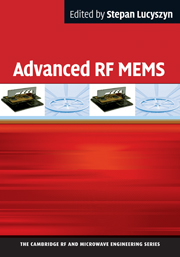Book contents
- Frontmatter
- Dedication
- Contents
- List of Contributors
- Preface
- List of Abbreviations
- 1 Introduction
- 2 Electromechanical modelling of electrostatic actuators
- 3 Switches and their fabrication technologies
- 4 Niche switch technologies
- 5 Reliability
- 6 Dielectric charging
- 7 Stress and thermal characterisation
- 8 High-power handling
- 9 Packaging
- 10 Impedance tuners and tuneable filters
- 11 Phase shifters and tuneable delay lines
- 12 Reconfigurable architectures
- 13 Industry roadmap for RF MEMS
- Author biographies
- Index
- References
13 - Industry roadmap for RF MEMS
Published online by Cambridge University Press: 05 February 2014
- Frontmatter
- Dedication
- Contents
- List of Contributors
- Preface
- List of Abbreviations
- 1 Introduction
- 2 Electromechanical modelling of electrostatic actuators
- 3 Switches and their fabrication technologies
- 4 Niche switch technologies
- 5 Reliability
- 6 Dielectric charging
- 7 Stress and thermal characterisation
- 8 High-power handling
- 9 Packaging
- 10 Impedance tuners and tuneable filters
- 11 Phase shifters and tuneable delay lines
- 12 Reconfigurable architectures
- 13 Industry roadmap for RF MEMS
- Author biographies
- Index
- References
Summary
Introduction
This chapter aims at provide a medium-term perspective for the future developments of RF MEMS technology up to 2020. This work is essentially based on the final report delivered by the EU-funded FP6 project Applied Research Roadmap for RF Micro/nano Systems Opportunities (ARRRO), a Coordinated Action whose aim was “to assess the current status and develop a vision of the future requirements for RF MEMS and RF NEMS technology, products and applications”. The roadmap described here is uniquely based on approximately 80 interviews with industrial companies (either developing or assessing the potential use of RF MEMS). Unlike other studies, which are based on data gained from the open literature, the findings presented here paint a more realistic future roadmap, from an industrial perspective.
Unlike ARRRO's report, which essentially refers to RF MEMS in the broad sense of RF microsystems technology (MST), only RF MEMS devices with movable parts are considered here. Having said this, reference is occasionally made to fixed micromachined devices (e.g. inductors), BAW and micromechanical resonators. With this in mind, a comprehensive roadmap in graphical form for RF MST components is shown in Fig. 13.1.
- Type
- Chapter
- Information
- Advanced RF MEMS , pp. 359 - 403Publisher: Cambridge University PressPrint publication year: 2010



